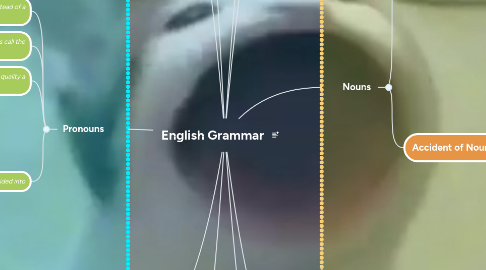
1. Grammar
1.1. Treats of the laws of language and the right of using it
2. The Verb
2.1. Form
2.1.1. Regular
2.1.1.1. A regular is one that forms its past tense in the indicative mood active and it past participle, by adding-ed to the present: present act, past acted, past participle acted
2.1.2. Irregular
2.1.2.1. An irregular verb is one that does not form its past indicative and past participle in this way
2.1.3. Number and person
2.1.3.1. In the each number, the verb has three person, the first, second, and third
2.1.3.2. Each tense of the verb has two Numbers, the Singular and the Plural
2.1.3.3. Conjugation is the regular combination and arrangement of all voices, moods, tenses, number and persons
2.1.4. Defective
2.1.4.1. A defective verb is one in which some of the parts are wanting. This class is comprised chiefly of Auxiliary and Impersonal verb
2.2. Meaning or Office
2.2.1. Transitive
2.2.1.1. A transitive verb expresses an act done by one person or thing to another
2.2.2. Intransitive
2.2.2.1. An intransitive verb expresses the being or state of its subject
2.2.3. Attributive
2.2.3.1. An attributive verb assert and connects
2.3. In formation of compound tense
2.3.1. Conjugation of the verb
2.3.1.1. Verb have four principle part
2.3.1.1.1. Present indicative
2.3.1.1.2. Present participle
2.3.1.1.3. Past indicative
2.3.1.1.4. Past participle
2.3.1.2. Conjugation is the regular combination and arrangement of all voices, moods, tenses, number and persons
3. Pronouns
3.1. A pronoun is a word used instead of a noun
3.2. The noun a pronoun replaces is call the antecedent
3.3. An Adjective is a word used to quality a noun
3.3.1. Nouns, pronouns, adverbs and preposition can be used as adjectives
3.4. Pronouns are divided into
3.4.1. Relative
3.4.2. Interrogative
3.4.3. Personal
3.4.4. Adjective
3.4.4.1. Possessive
3.4.4.1.1. Denote possession
3.4.4.2. Distributive
3.4.4.2.1. Represent object as taken separately
3.4.4.3. Demonstrative
3.4.4.3.1. Point out object definitely
3.4.4.4. Indefinite
3.4.4.4.1. Designate object indefinitely
4. Articles
4.1. An article is a word put before a noun to indicate the manner in which it is used
4.2. There are two articles, indefinite and definte
4.2.1. The indefinite article (a/an) denotes a noun without grammatical distinction
4.2.2. A definite article shows its noun refers to some particular person or thing
5. Adjectives
5.1. Adjectives are of four types
5.1.1. Quality
5.1.1.1. Sensible
5.1.1.2. Comparative
5.1.1.3. Relational
5.1.1.4. Definite
5.1.1.4.1. Cardinal
5.1.1.4.2. Ordinal
5.1.2. Participial
5.1.2.1. Descriptive
5.1.2.2. Verb
5.1.3. Quantity
5.1.3.1. Indefinite
5.1.3.2. Distributive
5.1.3.3. Measure
5.1.4. Circumstantial
5.1.4.1. Time
5.1.4.2. Place
5.1.4.3. Nation
5.2. Comparison of adjective
5.2.1. Some adjective cannot (should not) be compared
5.2.2. Three degree of comparison
5.2.2.1. Comparative
5.2.2.1.1. Expresses a quality in a higher degree
5.2.2.2. Positive
5.2.2.2.1. Expresses a quality
5.2.2.3. Superlative
5.2.2.3.1. Expresses a quality in the highest degree
6. Language
6.1. The means which we express our thoughts, either spoken or written.
7. Words
7.1. Word are either inflected or uninflected
7.2. An Inflected word is one which undergoes certain changes of from or termination
7.2.1. Nouns and pronouns are declined
7.2.2. Adjectives and adverbs are compared
7.2.3. Verbs are conjugated
7.3. In respect of signification and use, words are divided in class called Parts of speed
7.3.1. Words which attribute an action or state to a subject are verbs
7.3.2. Words which are manes of object are classed as nouns
8. Nouns
8.1. Nouns
8.1.1. A Nouns is the name of any person, place, quality or thing
8.1.2. Nouns are of two kinds, Proper and Common
8.1.2.1. A proper noun is the name applied to an individual only
8.1.2.2. A Common Noun is a name applied to all things of the same sort
8.1.3. The name of actions are called verbal nouns
8.2. Accident of Nouns
8.2.1. Person
8.2.1.1. Person is the distinction of nouns to denote the speaker, the person or thing spoken to, or the person or thing spoken of
8.2.2. Gender
8.2.3. Number
8.2.4. Case
8.2.4.1. Case is the state or condition of a noun with respect to the other words in a sentence
8.2.4.2. English has three case, the Nominative, Possessive and Objective
8.2.4.2.1. A noun is in the Nominative case when:
8.2.4.2.2. The possessive case connects the idea of origin, possession or fitness with a noun
8.2.4.2.3. The objective case is used to denote:
9. Conjunction
9.1. Conjunctions are word which connect words, phrases or sentences
9.2. Conjunctions are of two classes, copulative and disjunctive
9.2.1. A copulative joins sentences together and unites the meaning
9.2.1.1. Connective
9.2.1.2. Consultative
9.2.2. Disjunctive join two sentences together while disconnecting the meaning
9.2.2.1. Distributive
9.2.2.2. Adversative
10. Etymology
10.1. A word is an articulate sounds use by common consent as the sign of an idea
10.2. Word, in formation, are either Primitive or Derivative, Simple or Compound
10.2.1. A Primitive word is one that is not derived from another language
10.2.2. A Derivative word is one that is derived from some other word
10.2.3. A Simple word is one that is not combined with other word
10.2.4. A Compound word is one that is made up of two or more simple words
